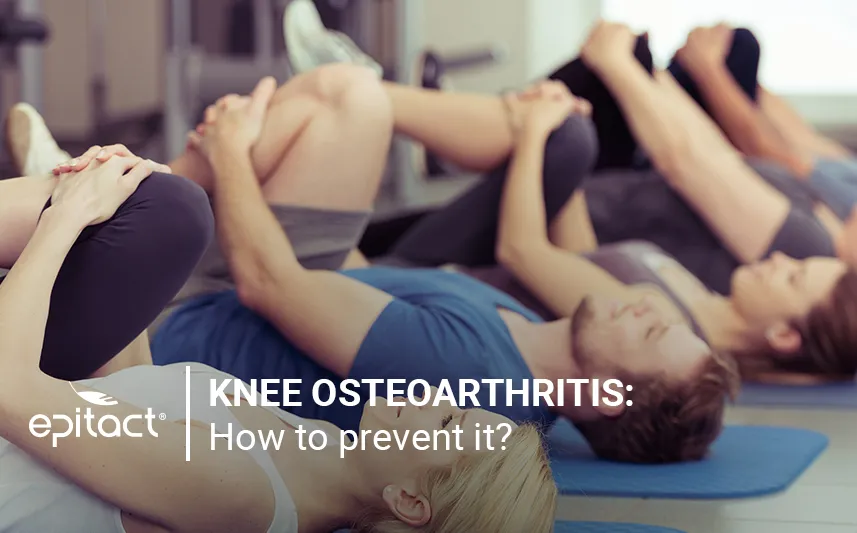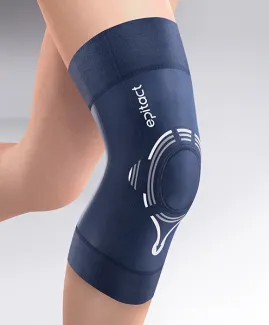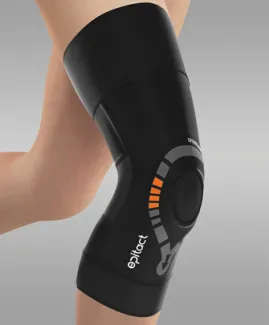
You can’t prevent or stop arthritis in your knees from appearing. However, it is possible to slow down its progression, improve mobility and relieve pain.
Osteoarthritis, a subtype of arthritis, is a degenerative condition that causes wear and tear of the knee joint cartilage. When the condition progresses, the cartilage keeps on deteriorating and becomes thinner, even leading to a bony contact. It can cause cracking, pain or stiffness in the joint.
Because it is irreversible, it is important to fight against the factors that increase the risk of developing arthritis as soon as possible!
Why should you prevent arthritis in your knees?
The knee is a very important joint that supports the body weight every day. There are different ways of stopping arthritis in the knee, which means to preserve the joint and avoid the condition becoming disabling.
Indeed, when knee arthritis worsens, it can lead to intense pain, loss of mobility and difficulties walking. By preventing the causes and factors of arthritis, you find effective pain relief, preserve your mobility and ability to do your daily activities.
First step to slow down arthritis: identify the risk factors
Arthritis in knees is often related to age, gender, genetic, morphological abnormalities, knee traumas or some diseases that are unavoidable. Although you can’t do anything about these factors, you can fight against other preventable ones.
Indeed, the early degradation of the cartilage is often due to joint overuse. This is the result of excessive involvement of the knee during daily activities: high pressures, sudden twists or repeated microtraumas. Such stresses can be caused by(1):
- excess weight on the joint (e.g.: obesity or sports like bodybuilding);
- prolonged or recurrent crouching or kneeling position (e.g.: tilers…);
- shocks and microtraumas to the knee which are frequent during contact sports (rugby, football, etc.).
Tips to stop knee arthritis worsening
1- Weight loss
Excess weight and obesity are both major aggravating factors for knee arthritis. Being overweight causes daily traumas to the joints that support the body weight. The risk of developing arthritis in the knee is 7 times greater for obese individuals(2)!
To sum up, losing weight decreases pressure on the knee joint and slows down the cartilage degradation and arthritis. A dietician or nutritionist can give you advice and help you chose an appropriate diet program.
2- Keep moving!
Contrary to popular belief, immobilising the knee is absolutely not a miracle cure to stop knee arthritis progression. On the contrary, you should stay active thanks to physical therapy but also physical activity.
Several muscles like the quadriceps insert on the kneecap, which contribute to joint stability. Daily strengthening exercises are a considerable asset to better control pressure and strengthen joint resistance.
In addition, range of motion exercises help to avoid potential joint stiffness and preserve function of the knee.
Exercises compensate for the degradation of the cartilage by stimulating nutrition and improving elasticity and tone of the joint tissues(3). See your physiotherapist for personalised advice and prefer sports like hiking, cycling, swimming, yoga or aquatic exercises for example.
3- Knee support
In addition to the aforementioned exercises, wearing a knee support helps to limit pressure on the affected knee compartment. By limiting the lateral deviation of the kneecap during movements, the EPITACT® medical knee support* reduces hyperpressure on the joint and relieves pain. It provides security to the knee, a sensation of stability and enables you to continue or resume your activities of daily living. This device has been specially created for patellofemoral osteoarthritis.
Knee injuries often require a period of rest that is not recommended in the case of arthritis. Therefore, be careful if your activity involves considerable twists in the knee. To secure your knee during sports practice, try the PHYSIOstrap™ SPORT* by EPITACT®>. This special knee support has a silicone tendon around the kneecap that helps to stabilise the joint without impeding mobility.
4- Can orthopaedic insoles help to stop arthritis in the knees?
Some morphological abnormalities like genu varum (bow legs) or valgum (knock knees) can cause knee arthritis. By modifying the distribution of loads on the joint, they generate excessive traumas to the cartilage. In some particular cases, orthopaedic insoles can correct the postural imbalances and so prevent knee arthritis from progressing.
A last tip to slow down knee arthritis?
Shoes with quality insoles absorb the shocks of the impact foot/ground and limit the damages to the knee. Think about it next time you’ll go shopping…
Arthritis is a chronic and irreversible disease. You can’t stop the progression but you can slow it down. So, before beginning a more specific treatment for knee osteoarthritis, follow the EPITACT®’s advice to preserve your knees!
*These solutions are class I medical devices that bear the CE marking under this regulation. Carefully read the instructions before use. Manufacturer: Millet Innovation. 11/2023
For more details about this general and simplified approach, here are further sources:
(1)Grange L. Stop à l’arthrose. edi8; 2016. 152 p.
(2)Lee R, Kean WF. Obesity and knee osteoarthritis. Inflammopharmacol. 1 avr 2012;20(2):53‑8.
(3)Brody LT. Knee osteoarthritis: Clinical connections to articular cartilage structure and function. Physical Therapy in Sport. nov 2015;16(4):301‑16.
 Pharmacie
Pharmacie
